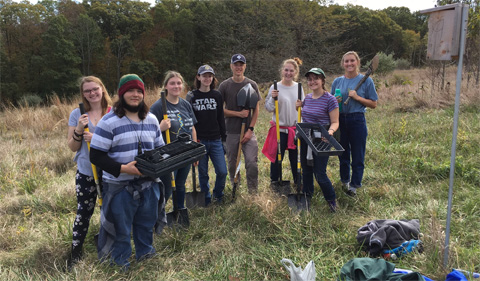Ohio University’s Environmental & Plant Biology Department has been working to help restore biodiversity on Radar Hill within The Ridges Land Lab for nearly a decade.
Dr. Rebecca Snell, assistant professor in the College of Arts and Sciences, teaches PBIO 3330 (Restoration Ecology) every other fall. Restoration ecology is the practice of repairing degraded or damaged ecosystem through human activities. Students in the class spend numerous hours working around the grassy areas on Radar Hill. The project’s main goal is to increase biodiversity on Radar Hill by introducing and maintaining native prairie plant species.
Historically, the area was managed and used by patients at the Athens Asylum (now called The Ridges). There were orchards planted along the road to Radar Hill, and Radar Hill itself was planted with a nonnative grass called meadow fescue and used for grazing livestock. Meadow fescue creates a thick mat on the ground, which prevents prairie plants from establishing. Meadow fescue is also a relatively short grass, resulting in a species-poor, low quality habitat for wildlife. The goal is to introduce native tall-grass prairie species, such as big blue stem, little blue stem, goldenrod, milkweed, and wild senna. The taller vegetation will help create vertical structure, provide habitat for more species and increase overall biodiversity.
“One prairie specialist that does really well up at Radar Hill is rattlesnake master,” says Snell. This is an ecologically interesting plant that looks like a yucca with a spiky flower and is an indicator of undisturbed prairie ecosystems.
“By helping restore the prairie on Radar Hill we are also helping restore and sustain the ecosystem,” Snell said. “Earth Day highlights environmental protection, and I think restoration is an excellent way for people to make a positive impact on the environment.”
The students taking this course spend a significant amount of time on Radar Hill helping restore the prairie through hands-on experience. Restoration was started by the 2013 Restoration Ecology class taught at the time by Dr. Jared DeForest, associate professor in Environmental and Plant Biology. By 2014, four 10-meter circular plots were established to act as hotspots of biodiversity on the northeast side of Radar Hill.
“Our overall intent was to improve biodiversity by seeding prairie species that would provide good habitat and food for insects, birds, and reptiles,” DeForest said. Since then, smaller plots have been established by subsequent students in restoration ecology. Students place black tarps on the meadow fescue and leave it for a few months, which results in the plant dying. This method is a safe and chemical-free way of killing the meadow fescue. Every spring this area is mowed to mimic the disturbance prairie species require to thrive and to discourage the growth of non-prairie plant species.
“This course allowed me to gain hands-on experience, which was big for me because I would like to work in the field where I can see the results of what I am doing first-hand. That is a big reason why I picked my major,” said Ridge Cook, a sophomore majoring in field ecology. “Making an effort to help restore ecosystems with my own hands brings me great satisfaction. We got to plant many native tallgrass prairie species and get an understanding of what this kind of ecosystem restoration can look like.”
Cook explains that restoration ecology is crucial to the Earth because, “We have greatly damaged our planet as humans and we have the opportunity to help turn that around. I want to engage myself in that process and help others to not lose sight of how important our natural environment is. Without a life-supporting planet, there is no humanity!”
For more information about OHIO’s Sustainability efforts visit https://www.ohio.edu/sustainability(opens in a new window).




















Comments